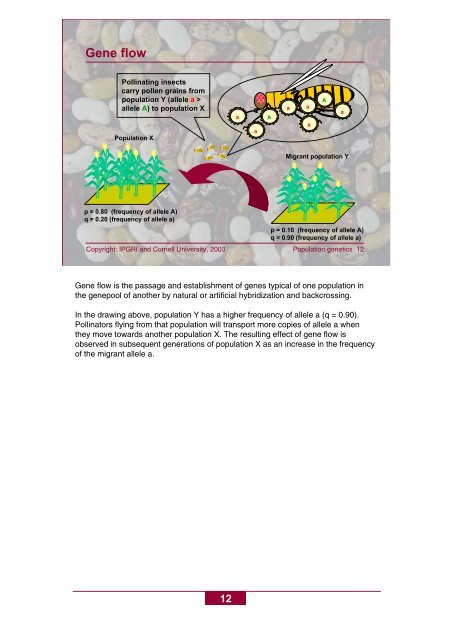Basic concepts of population genetics - Bioversity International
Basic concepts of population genetics - Bioversity International
Basic concepts of population genetics - Bioversity International
Create successful ePaper yourself
Turn your PDF publications into a flip-book with our unique Google optimized e-Paper software.
Gene flow<br />
Pollinating insects<br />
carry pollen grains from<br />
<strong>population</strong> Y (allele a ><br />
allele A) to <strong>population</strong> X<br />
Population X<br />
p = 0.80 (frequency <strong>of</strong> allele A)<br />
q = 0.20 (frequency <strong>of</strong> allele a)<br />
Copyright: IPGRI and Cornell University, 2003 Population <strong>genetics</strong> 12<br />
12<br />
a<br />
a<br />
A<br />
a a<br />
A a<br />
a<br />
Migrant <strong>population</strong> Y<br />
p = 0.10 (frequency <strong>of</strong> allele A)<br />
q = 0.90 (frequency <strong>of</strong> allele a)<br />
Gene flow is the passage and establishment <strong>of</strong> genes typical <strong>of</strong> one <strong>population</strong> in<br />
the genepool <strong>of</strong> another by natural or artificial hybridization and backcrossing.<br />
In the drawing above, <strong>population</strong> Y has a higher frequency <strong>of</strong> allele a (q = 0.90).<br />
Pollinators flying from that <strong>population</strong> will transport more copies <strong>of</strong> allele a when<br />
they move towards another <strong>population</strong> X. The resulting effect <strong>of</strong> gene flow is<br />
observed in subsequent generations <strong>of</strong> <strong>population</strong> X as an increase in the frequency<br />
<strong>of</strong> the migrant allele a.

















